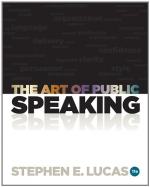Neither does exposition deal with reasons and inferences—that is the field of argument. A series of connected statements intended to convince a prospective buyer that one automobile is better than another, or proofs that the appeal to fear is a wrong method of discipline, would not be exposition. The plain facts as set forth in expository speaking or writing are nearly always the basis of argument, yet the processes are not one. True, the statement of a single significant fact without the addition of one other word may be convincing, but a moment’s thought will show that the inference, which completes a chain of reasoning, is made in the mind of the hearer and presupposes other facts held in consideration.[12]
In like manner, it is obvious that the field of persuasion is not open to exposition, for exposition is entirely an intellectual process, with no emotional element.
The Importance of Exposition
The importance of exposition in public speech is precisely the importance of setting forth a matter so plainly that it cannot be misunderstood.
“To master the process of exposition is to become a clear thinker. ’I know, when you do not ask me,’[13] replied a gentleman upon being requested to define a highly complex idea. Now some large concepts defy explicit definition; but no mind should take refuge behind such exceptions, for where definition fails, other forms succeed. Sometimes we feel confident that we have perfect mastery of an idea, but when the time comes to express it, the clearness becomes a haze. Exposition, then, is the test of clear understanding. To speak effectively you must be able to see your subject clearly and comprehensively, and to make your audience see it as you do."[14]
There are pitfalls on both sides of this path. To explain too little will leave your audience in doubt as to what you mean. It is useless to argue a question if it is not perfectly clear just what is meant by the question. Have you never come to a blind lane in conversation by finding that you were talking of one aspect of a matter while your friend was thinking of another? If two do not agree in their definitions of a Musician, it is useless to dispute over a certain man’s right to claim the title.
On the other side of the path lies the abyss of tediously explaining too much. That offends because it impresses the hearers that you either do not respect their intelligence or are trying to blow a breeze into a tornado. Carefully estimate the probable knowledge of your audience, both in general and of the particular point you are explaining. In trying to simplify, it is fatal to “sillify.” To explain more than is needed for the purposes of your argument or appeal is to waste energy all around. In your efforts to be explicit do not press exposition to the extent of dulness—the confines are not far distant and you may arrive before you know it.




